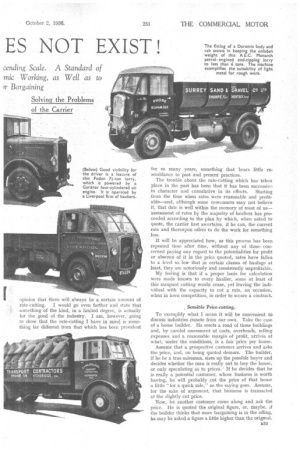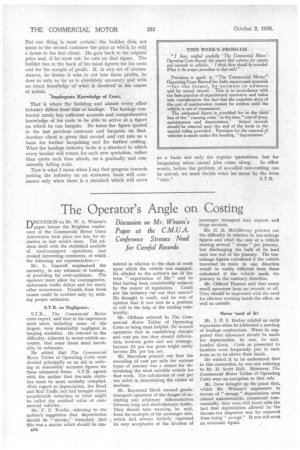RATE-CUTTING II
Page 42

Page 43

Page 44

If you've noticed an error in this article please click here to report it so we can fix it.
ES NOT EXIST!
Charges Cut on a Progressive, Rates Necessary to Ensure.
Provide a E
cending Seale. A .Standard of mic Working, as Well as to rr Bargaining
Solving .the Problems of the Carrier
/NOTE that it is ifow possible to purchase two 2d. packets of ice cream for 2d., which seems to indicate that there is a price-cutting war going on in the ice
cream industry. I anticipate that it will not be long before one of two things happens. Either the price-cutting concern will fail to pay a dividend, in which case there will be some searching questions put . by shareholders and 2d, packets of ice cream will again . come to be 2d., or, on the other hand, there will be an all-round reduction in price and a new rate will become standard.
. It is a great pity that the haulage industry is not yet in such a state that rate-cutting produces results so rapidly. The process which is called rate-cutting has now been going on for many years and the end does not appear to be in sight.
In actual fact, of course, there is no Such thing as rate-cutting in the haulage industry, for the simple reason that you cannot cut something which does not exist. There is, with certain exceptions, no schedule of stabilized rates and, therefore, no one can be charged with cutting rates. I expressed this opinion at a meet
-. ing of hauliers. The statement was not received with the approval and acclamation which I thought it deserved. Apparently, some of the audience thought it was a joke of dubious taste, whilst the rest could not conceive of it having any meaning at all.
No Fixed Price.
Yet the truth of the matter is beyond question. Time after time, for years and years, have I been asked such questions as: "What is the rate for a named material over a given distance?" Invariably, I have had to reply that there is no fixed price, that every haulier charges what he thinks fit and that there is a wide variation in the rates paid. I have followed this up by quoting the minimum which should be charged if a reasonable profit is to be made, and I have been made aware, in quite a number of cases, that the minimum rate has been cut to ribbons.
. No real progress will be made towards putting the industry on a sound and economic footing until some. thing is done to indicate what rates should be for a particular load carried in a particular type of vehicle. The way to achieve this end is not, as some seem to imagine, the compilation of a gigantic schedule of rates for all classes of material carried in all types and sizes of vehicle, over all variations of distance and under all conceivable conditions. The railway rates
book is complicated: it would be a flea bite in comparison with the volume which a road rates book would involve.
What is wanted is a simple basis for the calculation of rates, adaptable to all 'these various circumstances and capable of being utilized, by every haulier. Now, I am going to make yet another statement which is likely to be called in question. I am Of the opinion that there will always be a, certain amount of rate-cutting. I would go even farther and state that something of the kind, in a limited degree,. is actually for the good of the industry. I am, however, going to show that the rate-cutting I have in mind is something far different from that which has been prevalent for so many years, something that bears little resemblance to past and present practices.
The trouble about the rate-cutting which has taken place in the past has been that it has been successive
in character and cumulative in its effects. Starting from the time when rates were reasonable and profitable—and, althOugh some newcomers may not believe it, that date is well within the memory of most of us— assessment of rates by the majority of hauliers has proceeded according to the plan by which, when asked to quote, the carrier first ascertains, if he can, the current rate and thereupon offers to do the work for something less.
It will be appreciated how, as this process has been repeated time after time, without any of those concerned paying any regard to the potentialities for profit or absence of it in the price quoted, rates have fallen to a level so low that in certain classes of haulage at least, they are notoriously and consistently unprofitable.
My feeling is that if a proper basis for calculation were made known to every haulier, some at least of this rampant cutting would cease, yet leaving the individual with the capacity to cut a rate, on occasion, when in keen competition, in order to secure a contract.
, Sensible Price-cutting.
To exemplify what I mean it will be convenient to discuss industries remote from our own. Take the case of a house builder. He erects a road of these buildings and, by careful assessment of costs, overheads, selling expenses and a reasonable margin of profit, arrives at what, under the conditions, is a fair price per house.
Assume that a prospective customer arrives and asks the price, and, on being quoted demurs. The builder, if he be a true salesman, sizes up the possible buyer and decides whether the man is really out to buy the house, or only speculating as to prices. • If he decides that he is really a potential customer, whose business is worth having, he will probably cut the price of that house a little "for a quick sale," as the saying goes. Assume, for the sake of argument, that business is transacted at the slightly cut price.
Now, let another customer come along and ask the price. He is quoted the original figure, or, maybe, if the builder thinks that more bargaining is in the offing, he may be asked a figure a little higher than the original.
But one thing is most certain: the builder; does not quote to the second customer the price at which he sold a house to the first client. He goes back to his original price and, if he must cut, he cuts on that figure. The builder has in the back of his mind figures for his costs and for his margin of profit. If, in any set of circumstances, he deems it wise to cut into those profits, he does so only so far as is absolutely necessary and with an exact knowledge of what is involved in his course of action.
Inadequate. Knowledge of Costs.
That is where the building and almost every other industry differs from that of haulage. The haulage contractor rarely has sufficient accurate and comprehensive knowledge of his costs to be able to arrive at a figure on which he can bargain. He takes the figure quoted to the last previous customer and bargains on that. Another client is given that second and cut rate as a basis for further bargaining and for further cutting. What the haulage industry lacks is a standard to which every haulier will return for each new quotation, rather than quote each time afresh, on a gradually and consistently falling scale.
That is what I mean when I say that progress towards putting the industry on an economic basis will commence only when there is a standard which will serve as a basis not only for regular quotations, but for
bargaining when. casual jobs come along. In other words, before the problem of so-called rate-cutting can be solved, we must decide what we mean by the term
"rate." S.T.R.




















































































